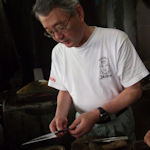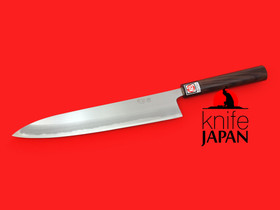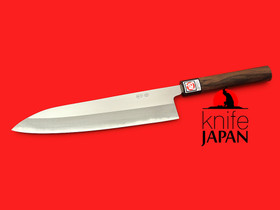Product Description
'Wa' is the slightly odd-feeling word in Japanese that in essence means 'Japanese' but can be understood to mean 'Japanese essence'. Something that is 'wa' is unique to Japanese culture. Most will have heard of wagyu, Japanese beef. Japanese homes, hotels and community centres usually have one or more washitsu, the Japanese room with tatami floor and shoji screens. Washoku is Japanese cuisine, wa-bocho, a Japanese knife.
The gyuto is better suited to 'non-wa' cuisine than is a single-bevel wa-bocho, which makes the wa-gyuto a western-leaning chef's knife in the traditional Japanese style. It makes sense, in a way. This is a knife for all seasons and all cooking styles.
The 210mm wa-gyuto has a double-bevel warikomi blade, hard blue#2 steel core encased in an outer layer of nantetsu. The symmetrical wa-handle is equally suited to left and right handers. It is crafted from red sandalwood, a prized hardwood, with a collar of water buffalo horn. It's a beautiful combination of materials in a simple and beautiful handle.
Ikenami Hamono forges knives for professional users throughout Japan. Tanegashima Island, where the company is based, has one of the longest histories of steel making and blade-craft of any region in the country. The island's knives are known as 'tane-bocho' and they are highly regarded for their beauty, utility and craftsmanship.
| Blade steel: | YSS Aogami #2 | nantetsu |
| Bevel: | Ryōba double bevel |
| Blade construction: | Warikomi |
| Left-handed available: | Handle and blade suit both hands |
| Handle: | Shitan (Red Sandalwood/Rosewood) |
| Ferrule: | Water buffalo horn |
| Blade length: | 210mm |
| Blade height: | 41mm |
| Blade spine: | 3.5mm |
| Handle length: | 128mm |
| Handle thickness: | 26x20mm |
| Weight in hand: | 180g (will vary) |


 Loading... Please wait...
Loading... Please wait...
















